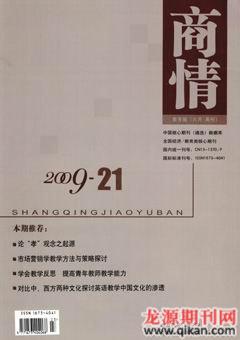On Speech Act Theory
鄧仁毅
Abstract:Speech act has developed from the work of linguistic philosophers and originates in Austins observation and study. It was the particular search for the constative, utterances which describe something outside the text and can therefore be judged true or false that prompted John L. Austin to direct his attention to the distinction with so-called performatives. The two representative linguists are Austin and Searle.
Key words:speech act utterance
1 The two kinds of meaning of utterances
First one is the propositional meaning, which is also known as locutionary meaning. This is the basic literal meaning of the utterance with is conveyed by the particular words and structures which the utterance contains. The second one is illocutionary meaning, which is also known as illocutionary force. This is the effect the utterance or written text has on the reader or listener.
For example, in "I am thirsty" the propositional meaning is what the utterances says about the speaker's physical state. The illocutionary force is the effect the speaker wants the utterance to have on the listener. It may be intended as a request for something to drink. A speech act is a sentence or utterance which has both propositional meaning and illocutionary force.
There are many different kinds of speech acts, such as request, orders, commands, complaints, promises. A speech act which is performed indirectly is sometimes known as an indirect speech act, such as the speech act of requesting above. Indirect speech acts are often felt to be more polite ways of performing certain kinds of speech act, such as requests and refusals. In language teaching, and syllabus design, speech acts are often referred to as "function" or "language functions".
2 The felicity conditions
It was the particular search for the constative, utterances which describe something outside the text and can therefore be judged true or false that prompted John L. Austin to direct his attention to the distinction with so-called performatives, i.e. utterances which are neither true or false but which bring about a particular social effect by being uttered . For a performative to have the desired effect, it has to meet certain social and cultural criteria, also called felicity conditions.
Felicity conditions are the conditions which must be fulfilled for a speech act to be satisfactorily performed or realized. The felicity conditions necessary for promises are:
First, a sentence is used which states a future act of the speaker. Second, the speaker has the ability to do the act. Third, the hearer prefers the speaker to do the act rather than not to do it. Fourthly, the speaker would not otherwise usually do the act. And at last, the speaker intends to do the act.
3 Three different aspects of an utterance and five speech act classification
In his essay, Austin abandons the distinction between constatives and performatives and replaced it by a new distinction between three different "aspects" of an utterance against the background of a generalised claim that all utterances are really performatives. This generalised claim is the key assumption of speech act theory , viz. by making an utterance, language users perform one or more social acts. These are called "speech acts". The threefold distinction is that between different types of action. For instance, by speaking an utterance, you may perform the social act of making a promise and, as a result, convince your audience of your commitment.
The philosopher Searle established a five-part classification of speech act: 1. commisive, a speech act that commits the speaker to doing something in the future, such as a promise or a threat. 2. declarative, a speech act which changes the state of affairs in the world. 3. directive, a speech act that has the function of getting the listener to do something, such as a suggestion, a request, or a command. 4. expressive, a speech act which the speaker express feelings and attitudes about someone. 5. representative, a speech act which describes states or events in the world, such as an assertion, a claim, a report.
4 Other linguists' contributions on speech act
A number of further important elaborations of speech act theory lie in the work of John Searle. One is that he allocates a central place to communicative intentions.At the same time, he develops a typology of speech acts.A third contribution of Searle is the development of a theory of indirect speech acts.
Yet, already in Searle's elaboration of the theory, there is an asocial, mentalist turn in the characterization of intentions as mental states stripped of all social content. At one point, Searle even states that the state of intentionality is "a biological phenomenon and is part of the natural world like any other biological phenomenon".
have criticized the universalistic claims of Searlean versions of speech act theory, showing its limited applicability to non-Western modes of communication. However, such a critique requires an elaboration in its own right to the extent that it is based on assumptions of cultural uniformity at the expense of variability and contradiction. Thus, as Verschueren notes, depending on the data context examined, speakers of English can be seen to hold conceptualizations of speech actions rather similar to those which linguistic anthropologists invoke to bring out ethnocentric bias.
The strict separation between locution and illocution in Austin's work can be criticised from within Derrida's writing. This criticism has a bearing on important debates within linguistics. First, for the act of speaking (locution) to be valid as a locution, an utterance must be grammatical and draw on a recognisable lexical wordlist. In this reading, a locution has meaning independently of the context in which it is used. Using the utterance in context amounts to lending it a particular force (illocution). In contrast with this view, one can argue that utterances tend to pre-empt a particular context of use as well as stress the extent to which "constatives" exist by virtue of "performatives".

